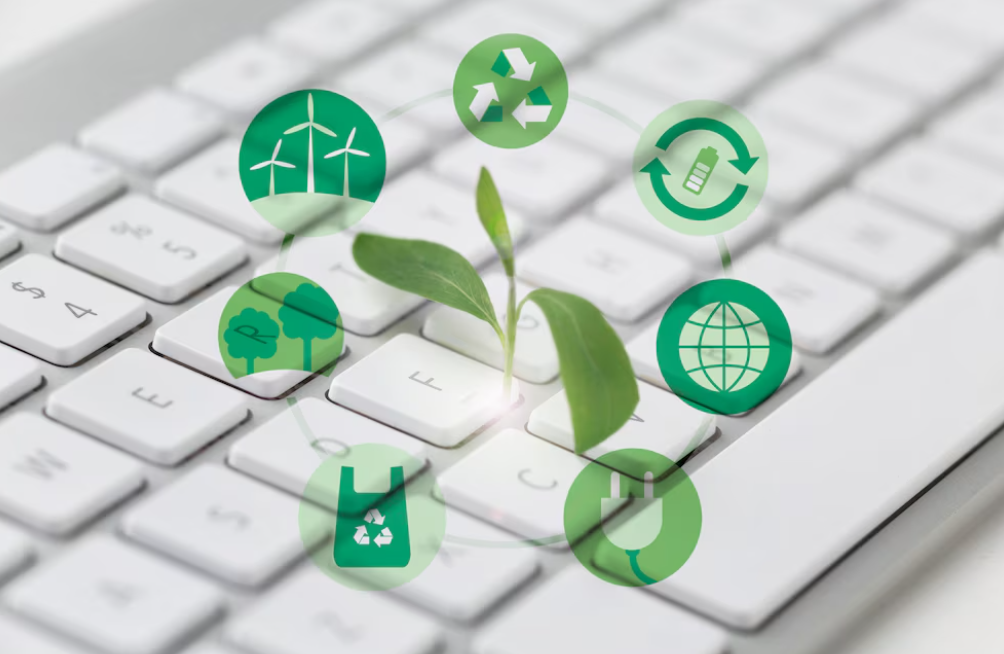
Information Technology
• It is the backbone of the progress for entire modern human race.
• With the growth, practically not measurable, the IT industry is proliferating very rapidly.
• India’s software industry is estimated to be worth about USD 1.2 billion, compared to ten years ago only USD 10 million.
• Nevertheless, the growth has been limited to only a few cities.
• Information technology is among the fastest growing industries in India, and employs more than 125,000 people.
• High quality and low cost manpower give the Indian software industry an advantage in the world market.
• The fact that India constitutes the second largest English speaking manpower resource in the world, is making the country even more competitive.
Ensuring safety and reducing Hazardous waste


In industries management of e-waste should begin at the point of generation.
• This can be done by waste minimization techniques and by sustainable product design. Waste minimization in industries involves adopting:
• inventory management,
• production-process modification,
• volume reduction,
• recovery and reuse.
Inventory management
• Proper control over the materials used in the manufacturing process is an important way to reduce waste generation. This can be done in two ways i.e.
• Establishing material-purchase review- that all materials be approved prior to purchase. In the approval process all production materials are evaluated to examine if they contain hazardous constituents and whether alternative non-hazardous materials are available.
• and Control procedures and Inventory tracking system-materials are ordered only on an as-needed basis and that only the amount needed for a specific period of time is ordered.
Production-process modification
• Changes can be made in the production process, which will reduce waste generation. This reduction can be accomplished by changing the materials used to make the product or by the more efficient use of input materials in the production process or both.
• Potential waste minimization techniques can be broken down into three categories:
i) Improved operating and maintenance procedures,
ii) Material change and iii)Process-equipment modification
Standard operation procedures, strict maintenance program and strict maintenance program

• Instituting standard operation procedures can optimise the use of raw materials in the production process and reduce the potential for materials to be lost through leaks and spills.
• A strict maintenance program, which stresses corrective maintenance, can reduce waste generation caused by equipment failure.
• An employee-training employee-training program is a key element of any waste reduction program. Training should include correct operating and handling procedures, proper equipment use, recommended maintenance and inspection schedules, correct process control specifications and proper management of waste materials.
Replace Hazardous materials used in either a product formulation or a production process with less hazardous

• For example, a circuit board manufacturer can replace solvent-based product with water-based flux and simultaneously replace solvent vapor degreaser with detergent parts washer.
• manufacturing operations, which involve coating a product, such as electroplating or painting, chemicals are used to strip off coating from rejected products so that they can be recoated. These chemicals, which can include acids, caustics, cyanides etc are often a hazardous waste and must be properly managed. By reducing the number of parts that have to be reworked, the quantity of waste can be significantly reduced.
Volume reduction
• Volume reduction includes those techniques that remove the hazardous portion of a waste from a non-hazardous portion .e.g. use compaction equipments to reduce volume of waste cathode ray-tube.
• waste-stream volume can be divided into 2 general categories: source segregation and waste concentration.
• Concentration of a waste stream may increase the likelihood that the material can be recycled or reused. Methods include gravity and vacuum filtration, ultra filtration, reverse osmosis, freeze vaporization etc.
• Wastes containing different types of metals can be treated separately so that the metal value in the sludge can be recovered. E.g. a printed-circuit board manufacturer can use electrolytic recovery to reclaim metals from copper and tin-lead plating bath.
• Recycling of hazardous products has little environmental benefit if it simply moves the hazards into secondary products, such recycling is a false solution.
Sustainable product design
• Rethink the product design: Efforts should be made to design a product with fewer amounts of hazardous materials. For example, the efforts to reduce material use are reflected in some new computer designs that are flatter, lighter and more integrated. Other companies propose centralized networks similar to the telephone system.
Use of renewable materials and energy:
• Bio-based plastics are plastics made with plant-based chemicals or plant-produced polymers rather than from petrochemicals.
• Bio-based toners, glues and inks are used more frequently.
• Solar computers also exist but they are currently very expensive.
Use of non-renewable materials that are safer:
• Because many of the materials used are non-renewable, designers could ensure the product is built for re-use, repair and/or upgradeability.
• Some computer manufacturers such as Dell and Gateway lease out their products thereby ensuring they get them back to further upgrade and lease out again.
Regard for environmental or worker health and safety.
• A recent investigation revealed that much of the electronics turned over for recycling in the United States ends up in Asia, where they are either disposed of or recycled with little or no regard for environmental or worker health and safety. Major reasons for hazardous waste exports are
• Cheap labour
• Lack of environmental and occupational standards in Asia and
• Lack of appropriate management measures to prevent the hazards and mishaps due to mismanagement of e-wastes.
• in this way the toxic effluent of the developed nations ‘would flood towards the world’s poorest nations.
Management options for the government, industries and the public.
• Collect basic information on the materials from manufacturers, processors and importers and to maintain an inventory of these materials. The information should include toxicity and potential harmful effects.
• Identify potentially harmful substances and require the industry to test them for adverse health and environmental effects.
• Control risks from manufacture, processing, distribution, use and disposal of electronic wastes.
• Encourage beneficial reuse of “e-waste” and encouraging business activities that use waste”.
• Set up programs so as to promote recycling among citizens and businesses.
• Educate e-waste generators on reuse/recycling options
Responsibility and Role of industries
• Generators of wastes should take responsibility to determine the output characteristics of wastes and if hazardous, should provide management options.
• All personnel involved in handling e-waste in industries should be properly qualified and trained.
• Companies can adopt their own policies while handling
e-wastes. Some are given below:
• Use label materials to assist in recycling (particularly plastics).
• Standardize components for easy disassembly.
• Re-evaluate ‘cheap products’ use, make product cycle ‘cheap’ and so that it has no inherent value that would encourage a recycling infrastructure.
• Create computer components and peripherals of biodegradable materials.
• Utilize technology sharing particularly for manufacturing and de manufacturing.
• Encourage / promote / require green procurement for corporate buyers. Look at green packaging options.
Designs infrastructure to recover and reuse every material contained within e-wastes
• Metals such as lead, copper, aluminum and gold, and various plastics, glass and wire. Such a “closed loop” manufacturing and recovery system offers a win-win situation for everyone
• Manufacturers of computer monitors, television sets and other electronic devices containing hazardous materials must be responsible for educating consumers and the general public regarding the potential threat to public health and the environment posed by their products.
Responsibilities of the Citizen
• Donating electronics for reuse extends the lives of valuable products and keeps them out of the waste management system for a longer time. But care should be taken while donating such items i.e. the items should be in working condition. By donating used electronics, schools, non-profit organizations, and lower-income families can afford to use equipment that they otherwise could not afford. E-wastes should never be disposed with garbage and other household wastes.
• Customers should opt for upgrading their computers or other electronic items to the latest versions rather than buying new equipments.



